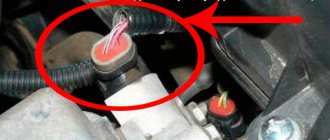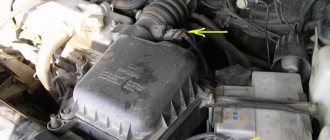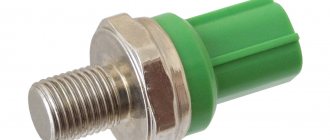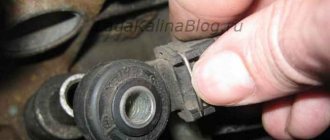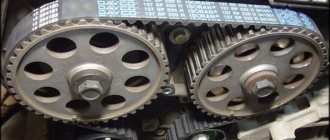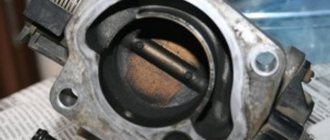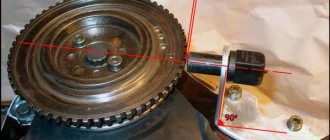Methods for checking a knock sensor
If there are signs of a malfunction of the knock sensor, then first of all you need to check the error log in the on-board computer. About DD malfunction they say:
- code 0325, indicates an open circuit in the sensor circuit;
- code 0326 or 0327, reports low signal level;
- code 0328, the amplitude of the voltage coming from the sensor is too high.
You can indirectly check the DD by checking the resistance with a multimeter. For a working sensor it ranges from 1 to 10 MOhm.
You should also check the voltage with a multimeter. To do this, the probes are connected to the contacts, and light blows are applied to the working surface of the DD with a bolt or rod. If there are no voltage surges, the sensor needs to be replaced.
Measurements
Now you can check with a multimeter set to the minimum value. If the sensor is single-contact, then the negative wire of the multimeter (it is usually black) is connected to the place where the mounting bolt is installed, and the positive wire (usually red) is connected to the signal contact in the connector.
Checking the two-contact sensor is carried out by connecting the multimeter wire to the corresponding contact “-” to “-”, “+” to “+”. Further actions are identical. To activate the sensor, you need to tap it with something not very hard (for example, a screwdriver).
If there are no faults, voltage surges will be observed. Approximately 40 to 200 mV. In addition, it would not hurt to check the internal resistance, which should tend to zero. If you find that the sensor is fine, then look for an open circuit. In this case, the best advice is to replace the entire block with wires.
If the resistance is different, or there are no voltage surges, it means that there is something wrong with the sensor itself and it needs to be replaced. The new one is installed in the reverse order of removal.
Checking the serviceability, maintenance and replacement procedure for the VAZ 2110 knock sensor
The principle of operation of a device such as a knock sensor is similar on all modern vehicles. This device is quite reliable and consists of a homogeneous monolith with an integrated special plate with a piezoelectric element, which responds to shock at the desired frequency. It is this wave action with a certain frequency that is formed in the cylinder block of a power plant during combustion of the air-fuel mixture.
The electrical current with a voltage of several millivolts, which appears as a result of this influence, serves as the source of measurements that are fed to the car's on-board computer. And the electronic system of the vehicle adjusts the ignition timing, neutralizing with these actions possible shock effects that occur during fuel detonation.
Despite the fact that the VAZ 2110 knock sensor, the price of which is quite reasonable, has small linear dimensions and is very simple in design, its importance can hardly be overestimated. After all, the loss of the switching signal from this product leads to the display of the corresponding failure code on the display of the on-board computer, which is deciphered in the VAZ 2110 as a knock sensor error and leads to the transfer of the ECU to a safe operating mode.
This, in turn, optimizes the software costs of the electronic control unit, adjusts the ignition timing to a minimum value, which leads to an increase in fuel consumption and a decrease in the dynamic power of the car.
If the knock sensor breaks, the vehicle is operated for a certain period of time without this setting. The same applies to the case when faults are identified in the knock sensor, but it is not possible to replace it. In any case, there is no point in delaying repairs or replacement of this device.
DEVICE AND PURPOSE
The basis of the knock sensor (DS) is a piezoelectric element. When mechanically applied, an electrical impulse is generated on it, this impulse is sent to the engine control unit. The electronics detects the occurrence of detonation and, based on the data obtained, adjusts the ignition angle, thereby protecting the internal combustion engine (ICE) from mechanical damage.
To find out where the knock sensor is located on a VAZ 2114, you need to open the hood and look under the cylinder head between the second and third cylinders; it is installed on the internal combustion engine block (this can be seen in the figure above). On a 16-valve engine it will be more difficult to see right away; the cylinder head is more massive and blocks the view.
There are two types of DD:
- Resonant (single-contact),
- Broadband (two-contact) sensors.
What types of DD are there?
The resonant knock sensor was installed on early releases of VAZ 2113, VAZ 2114 and VAZ 2115 cars (they are completely interchangeable). It is rarely found on sale lately, and the price of the part is quite high. A single-contact knock sensor works on the principle of capturing the detonation frequency, while a broadband (two-contact) sensor receives the entire noise band, and then detects detonation noise in it. These devices are not interchangeable, as they operate on different principles. Replacing the wiring does not solve the problem, so when remaking the system, you also have to change the electronic control unit (ECU).
But replacing the ECU is ultimately worth it, given the difference in price of the parts. A resonant DD from GM costs approximately 2,600 rubles. At the same time, the price of broadband DD is in the range of 230-320 rubles. If desired, a spare part can be found even cheaper, for example, a two-pin DD manufactured by StartVolt is sold at a price of 170-210 rubles. It makes sense to redo the entire system once rather than constantly have to worry about finding and replacing a single-contact knock sensor.
Location of the knock sensor on the VAZ 2110
The location of the knock sensor was chosen to obtain the greatest sensitivity. To do this, it is installed directly on the power unit between the second and third cylinders. The oil dipstick can serve as a guide for determining the installation location. Also in close proximity is the air filter housing.
What is a knock sensor and why is it needed?
This part is found in cars that use gasoline as fuel. It is intended for injection types of engines. The sensor is located on the engine cylinder block. This is an important part of the control system, the main purpose of which is to control the level of detonation.
There is a similar article on this topic - What is engine chip tuning, pros and cons.
In answering the question of what the knock sensor is responsible for , it should be noted that thanks to it the following vehicle capabilities are realized:
- Fuel economy.
- The ability of the engine to develop maximum power.
Detonation is the electrical impulse created during ignition. It is thanks to detonation that the car starts, complex chemical and physical processes occur inside the engine, and the fuel ignites.
The sensor monitors the vehicle's starting system and regulates its proper operation.
What are the main components of a knock sensor?
The main details of this mechanism are:
- Vibrating plate.
- Piezo type electrical element.
- Signal wire.
- Braid.
How to change the sensor?
If this element fails, it must be replaced. Fortunately, spare parts for the VAZ-2110 can be found in any store for a low price. A new knock sensor will cost no more than 250 rubles. How to replace it? First you need to find the element itself. As we said earlier, it is located between the second and third cylinder.
Then, using a 12 mm wrench, unscrew the mounting bolt. Next, you need to press on the plug of the wire clamp and pull it out. Afterwards you can remove the sensor itself. At the next stage, a new spare part is installed on the VAZ-2110. Having installed the plug with the wires, you should screw back the mounting bolt with a 12mm wrench. At this stage, replacing the knock sensor on the “ten” can be considered complete.
Dismantling
First you need to find the sensor. It is located on the left side of the engine, where the line is half of the cylinder block. Next to it is the air filter.
To determine the malfunction or its absence, it is necessary to remove it in the following sequence:
- Disconnect the car from power by removing the negative terminal from the battery;
- Disconnect the block with wires from the contacts of the knock sensor. To do this, press the latch;
- Unscrew the nut securing the device and remove it from the mounting stud.
Please note that during further installation or replacement you will need a torque wrench (tightening force should be 20 Nm).
Replacing the knock sensor
Frequency of work to replace the tens knock sensor:
- Disconnect the negative power cable from the battery.
- Disconnects the product wiring from the wiring block.
- We remove the fasteners of the product and dismantle it.
- To activate the knock sensor, you need to knock on the body of the product.
- If the device is in working order, the product will show jump-like values of the potential difference within the limits of 40 to 200 mV.
If necessary, it is possible to measure the resistance of the internal circuit of the part. It is important to remember that this value for devices of this type is very large, tending to infinity.
If at least one indicator (resistance or voltage) is missing, you need to buy a new product and prepare to replace the VAZ 2110 knock sensor, since there are no other ways to resuscitate it.
Self-replacement of sensor 21120385501001 on a VAZ 2110
Replacement of the resonance sensor is carried out according to the instructions below
- Disconnect the connector.
- Unscrew the sensor.
- Remove the sensor.
- Install a new sensor, tightening to a torque of 20 Nm.
- Connect the connector.
How does a knock sensor work?
Car engines can use one of two types of knock sensors: resonant and broadband. But since the first type is already outdated and is rare, we will describe the operation of broadband sensors (WS).
The design of a broadband DD is based on a piezoelectric element, which, when subjected to mechanical action (that is, during an explosion, which, in essence, is detonation), supplies a current with a certain voltage to the electronic control unit. The sensor is configured to perceive sound waves in the range from 6 Hz to 15 kHz. The design of the sensor also includes a weighting agent, which enhances the mechanical effect on it by increasing the force, that is, it increases the sound amplitude.
The voltage supplied by the sensor to the ECU through the connector terminals is processed electronically and then a conclusion is made whether there is detonation in the engine, and accordingly, whether the ignition timing needs to be adjusted, which will help eliminate it. That is, the sensor in this case is only a “microphone”.
How to check a newly purchased VAZ 2112 knock sensor or the condition of an old one
Despite the low cost of the product, there are often cases of purchase when you receive a low-quality VAZ 2112 knock sensor or just a dummy disguised as one. Therefore, it will be useful to understand exactly how to check and diagnose a sensor removed from a car or purchase a new one.
To check, you will need an electrical multimeter. set to a measurement range of 200 mV DC voltage. Connect the probes of the device to the connectors of the broadband sensor to measure electrical quantities (in the case of a resonant one, one probe measures relative to the body).
Tap the sensor body with a screwdriver. The absolute voltage values recorded by the device will directly depend on the degree of physical impact on it: the stronger the impact, the higher the voltage pulse. If the dependence can be traced, then the DD is working.
Now we switch our multimeter to measuring resistance. The measured ohmic load in a working sensor should be in the range from 1 to 10 MOhm. Naturally, a faulty DD or its dummy will show infinite resistance, and a broken one will show very small resistance, on the order of a few tenths of an ohm.
Signs of malfunction of the knock sensor VAZ 2114
The knock sensor of the VAZ 2114 is a device on the serviceability of which the overall performance of the engine of the fourteenth depends. If the sensor fails, you will notice the following changes in the operation of the car:
- twitching of the internal combustion engine of the car;
- reduction in power indicators;
- an error appears on the instrument panel;
- increasing engine operating temperatures and rapid heating;
- increased fuel consumption;
- persistent smell of gasoline.
In order to understand the reason for the incorrect operation of the internal combustion engine, it is necessary to connect a diagnostic tool. Such a device allows you to read and display the code of a particular error. In our case, the following codes are distinguished: from 0325 to 0327 inclusive. All of them indicate that the sensor is not working properly.
Sensor cost
The sensor has extremely low maintainability, so if it fails, it must be replaced with a new sensor. On cars with engines with 8 and 16 valves, sensor 21123855020, manufactured by Lada, is installed. Its price is 180-400 rubles. If it is impossible to purchase the original, you should buy any of the analogues presented in the table below.
Table - Good analogues of the original Lada Priora knock sensor
| Manufacturer | vendor code | Approximate cost, ruble |
| Decaro | 2112-3855020 | 360-490 |
| Road map | 21123855020 | 260-380 |
| Samara 2112 | 3855020 | 200-250 |
| Fenox | SD10100O7 | 210-420 |
| ERA | 550489 | 300-340 |
Final result
Finally, a few words about installing the sensor after checking it. Remember that the metal surface of the sensor must be clean and free of debris and/or rust. Clean this surface before installation. Similarly with the surface on the sensor seat on the engine housing. You also need to perform preventative cleaning. The sensor contacts can also be lubricated with WD-40 or its equivalent for preventive purposes. And instead of the traditional bolt with which the sensor is attached to the engine block, it is better to use a more reliable pin. It secures the sensor more tightly, does not loosen the fastening and does not unwind over time under the influence of vibration.
Where is the knock sensor located?
Depending on the make of the car, the location of the sensor may vary, but it is always located on the engine body. The part itself is very small, about the size of a matchbox.
Part installation features
An important feature of installing the sensor is the presence of an electronic ignition system in the car. If it is not there, then there is no sensor. Older models do not have a knock sensor. It is also not installed on carburetor engine systems.
The operation of a modern car's sensor is displayed on an electronic panel in the cabin. If there is a malfunction, the car owner will immediately notice it.

